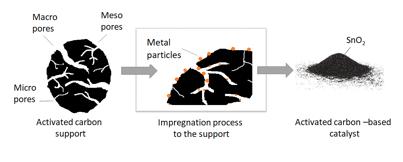2.2 WP2.1 Hydrolysis lignin raw materials 2.2.1 METHOD SEKAB kindly provided hydrolysis lignin. The provided hydrolysis lignin contained quite high concentrations of sugars. Therefore, enzymatic hydrolysis was conducted in order to reduce the sugar content and increase the relative concentration of klason lignin. In brief, the hydrolysis lignin was hydrolysed using 0.1 g/g DM enzymes in a 50 L bio reactor. The reaction was performed at 50°C, pH: 4.9 – 5.2. The hydrolysis lignin was recovered by filtration via a filter press.
Washing of hydrolysis lignin The hydrolysis lignin was washed with acids, bases as well as organic solvents under varying conditions, e.g. time, temperature and ratio between hydrolysis lignin and solvent aiming at obtaining a purer lignin. The effect of washing was evaluated by analysing the lignin fraction of the dried hydrolysis lignin after washing.
Oxidation of hydrolysis lignin The hydrolysis lignin was also oxidized using two different methods, ozone and hydrogen peroxide. For oxidation by ozone, the hydrolysis lignin was first dissolved in a non-polar solvent which was mixed with water. The dissolved hydrolysis lignin was subsequently subject for oxidation. The reaction conditions were varied by controlling the flow rate of the ozone gas, where higher rates result in higher exposure of the oxidizing agent, and temperature, which has a positive influence on reaction speed. The dissolved hydrolysis lignin was later recovered by making the solution more concentrated and subsequently adding it drop-wise to acidified water where the hydrolysis lignin is no longer soluble and therefore precipitates as a solid. The solid was recovered via filtration and then dried. For oxidation experiments using hydrogen peroxide, the hydrolysis lignin was added to a solution of formic acid and stirred at room temperature for 10 minutes. Hydrogen peroxide was then added and stirred for another 30 minutes. The solution was subsequently heated to 30-80°C for 1-5h. The progress of the oxidation reaction was followed via a special kit targeting peroxide and the oxidation was terminated via a combination of filtration, volume reduction and precipitation in acidic water. The solid precipitate was filtered and then washed with water before it was dried at room temperature. Milder oxidation conditions were also evaluated by conducting the experiment at a lower lignin and hydrogen peroxide concentration and reducing the temperature using an ice bath. Furthermore, instead of precipitating the lignin via dropwise addition of the lignin solution to acidified water, water was added to the lignin solution, which was subsequently filtered and washed with water until the washing solutions were pH neutral. The solid residue was dried at room temperature. The size of the hydrolysis lignin was evaluated using size exclusion chromatography, which is a separation technique that separates the lignin molecules based on their sizes and molecular weights.
Functionalization of hydrolysis lignin Lignin reactivity may be modified via the introduction of new functional groups and new reactive sites. Alkylation is one of the most well-known chemical modification reactions attempted on lignin in which phenolic and aliphatic hydroxyl groups of lignin can be converted to less reactive phenyl methyl ether/ aliphatic methyl ethers. It has been reported that DMS can selectively methylate all phenolic hydroxyl groups while DMC can methylate both phenolic and aliphatic hydroxyl groups (Scheme 1).
18
GREEN BIORAFF SOLUTIONS








